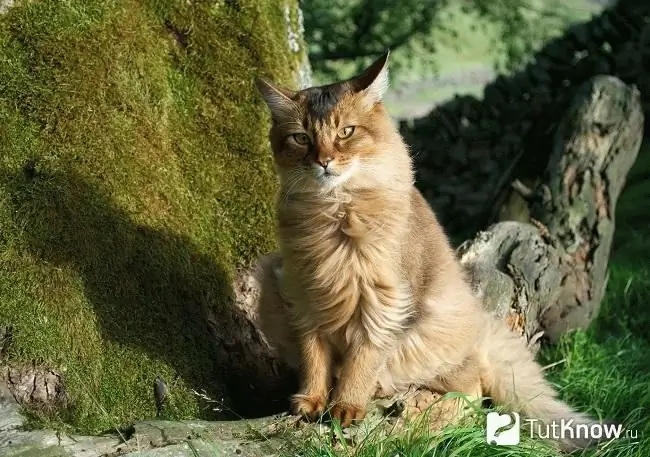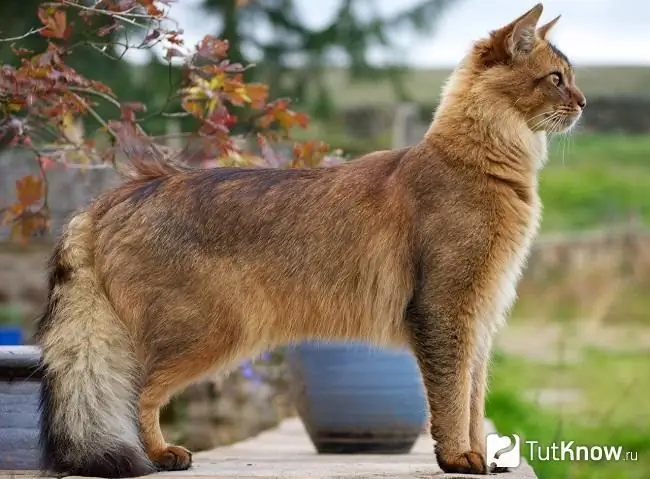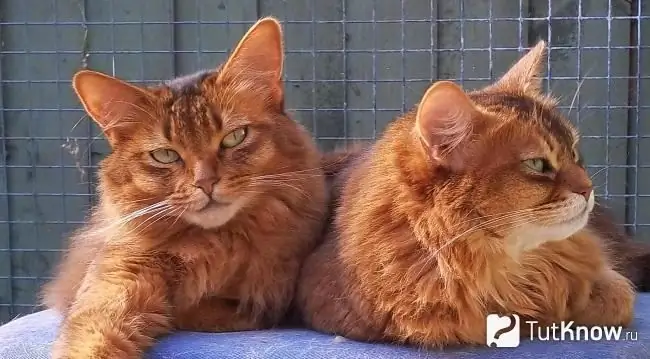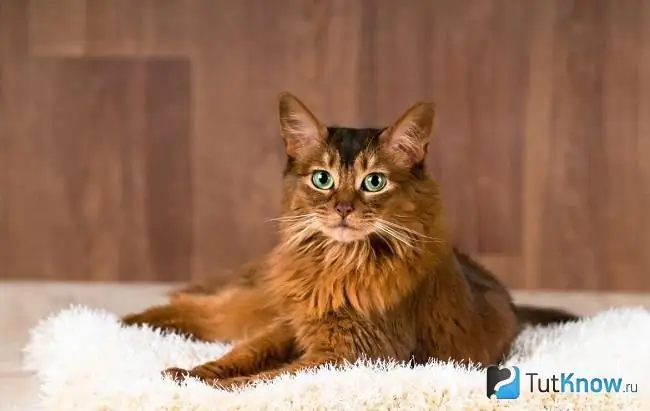The history of the origin of the Somali cat, a description of the standard of appearance, characteristics of the character of pets, health, keeping the animal at home, the price of a kitten. The Somali cat, or, as it is also customary to call it Somali (Somali), is a representative of the large world of pets, which has received from nature many positive qualities that cannot fail to bribe anyone who is lucky enough to meet these fluffies on their way. Smart, active and playful kittens, also possessing a cute face and extraordinary beauty of a fur coat, happily and easily find a common language with all family members. Surprisingly, such a pet as Somali is just crazy about little children, because most often they are the most active, and the cat will always support any game and will be able to turn every everyday day into a small, but still a holiday.
If, when choosing a pet, you opt for this type of cat, then we can say with absolute certainty that you will never regret your decision. Having brought this smart and curious pet to the house, after a few days of living together with him, you are unlikely to be able to imagine your future life without him. The Somali cat always knows what and how to do, and most importantly, at what time. Such an animal knows when it is better to invite the owner to play, when to lie down by his side and emit an encouraging purr, but when it is better to spend time alone with himself.
History of the origin of the Somali cat

In addition to excellent external and intellectual data, representatives of this breed also have a rather interesting history of appearance in our world. According to many scientific sources, the ancestors of Somali cats began to appear a very long time ago, in the territory of modern Ethiopia. In those days, the cats of these areas were different, and Ethiopia was not, as such, the country was then called Abyssinia. It was there that it was extremely popular to keep in the house a beautiful, purring pet, with a beautiful silky, but short hair. These cats were at the peak of popularity in earlier times, to say nothing of modern times. As for the name of the breed, they decided to name these representatives of the kingdom of cats in honor of their homeland - Abyssinians.
Around the middle of the 40s of the last century, the cat breeder Jennet Robertson traveled to the territory of Abyssinia, it was this woman who noticed in the aboriginal cats some special charm and charisma. She began to "promote" the breed in more developed countries of the world, thus, relatives of the Abyssinians have already begun to settle in the lands of Australia, New Zealand, the USA and Canada. It would seem that everything went smoothly, the fame of the new cats from the African continent began to reach the inhabitants of Europe, but not everything went as planned.
The thing is that these already popular and elite purrs began to give birth to unusual babies, and their unusualness was in the uncharacteristic length of their fur. The reasons for this could not be found, either one of the cats decided to independently choose a mating partner for itself, or this mutation happened by itself. These long-haired kittens were not only not sold, they were even hidden from the public with all their might, since, according to the breeder, they were “defective”. Such "nedo-Abyssins" were handed out simply for free to all comers.
The little-known cat breeder Mary Mayling became such a happy owner of a fluffy pet, but with flaws in appearance. It was she who thought that it was unfair to call such amazing creatures "defective" and in the 60s of the last century decided to show her pet at one of the major exhibitions in Canada. There was a fluffy and his success awaited, many felinologists were seriously interested in the cat, one of which was the American Evelyn Magu. This woman began a program for breeding a new breed of cats, which they decided to call Somali or Somali, in honor of the neighboring state of Abyssinia.
So Somali cats slowly but surely began to join the ranks of purebred, in 1972 the Somali Fan Club was opened, and in 1978 these cats were officially recognized as purebred in the United States. Four more years later, and the Somali cat or Somali was included in the list of FIF breeds.
Somali cat: description of the breed standard and photo

- Torso Somali cats are of medium size, sexual dimorphism in terms of parameters is not very pronounced. The average body weight of an adult male varies in the range from 4 to 6 kg, while the fair half is slightly less. The body of the Somali is very graceful and graceful, not too long in length, usually the body length does not exceed 30 cm. This type of cat has very well developed muscle tissue. A gentle curve can be seen on the dorsal side. The rib cage is wide, with a rounded configuration. Due to this combination of external features, at the first glance at the animal, one might think that the cat is about to jump.
- Limbs Somali cats are moderately long, very correctly in harmony with the general parameters of the body, end with legs that resemble an oval in shape. It is characteristic that these seals walk exclusively on toes, of which there are five on the front legs and four on the hind legs. They also have a plantar band.
- Tail process relatively long. It is noteworthy that at the base the organ of balance is of considerable width, and towards the tip it smoothly and harmoniously tapers. The tip of the tail of the Somali is always decorated with a beautiful tuft of fur hanging down, which in appearance resembles a plume.
- Head Somali cats in configuration resembles a slightly modified wedge, slightly rounded. The muzzle of the animal is completely devoid of any sharp lines, transitions or sharp corners, all outlines are smooth and soft. The nose is small, a slight bend is possible to see only in profile. From the protruding parts of the skull, one can hardly identify the not very visualized cheekbones and a small, strong, rounded chin. Often cats from the African continent are compared to foxes, due to the similar shapes and outlines of the muzzle.
- Eyes This representative of the feline kingdom is much larger than average in size, resembling an almond in shape. As for the "soul mirrors" of the Somalis, the standard of the variety clearly states that in no case can the eyes of a purebred cat be round. In addition, a border should always be drawn around the eyes in dark shades, as if someone had tinted the eyes with a black pencil. The look is open and clean. If we talk about the colors of the iris, then the standard allows for any gamut of shades ranging from yellowish to deep green.
- Auricles Somali seals are rather big, it seems that the animal is always excited about something, always keeps its ears open. From the tip, which is decorated with small tassels, the auditory organs expand noticeably towards the base. The basilar part of the ear is bowl-shaped. Minor tufts of fur can be seen inside the ears.
- Wool Somali cats are notable mainly for the fact that there are a lot of them, they are double. Although it is quite dense in texture, it is soft and pleasant to the touch. The thicker the coat on the body of the Somali, the better. Only in the projection of the shoulder blades, the hairs can be somewhat shorter. Also, according to the standard, such pets should have a "collar" and "pants", as well as bunches of long hair between the toes.
- Color The Somali cat usually consists of a pitch and a ticking color. Purebred animals should not have any patterns on the belly and on the tail, only areas of darkening of the fur along the spinal column, on the hocks, elbows and antennae pads are allowed. Also, a dark line should extend from the eyes towards the ears. The breed standard allows for the following Somali color options: red, blue, purple and wild.
The nature of Somali cats

Although outwardly these purrs a little resemble a chanterelle, they have nothing in common with wild animals. On the contrary, these cats are very good-natured and peaceful. They will never show aggression, but they will not tolerate it in relation to their personality. This is especially true of young children, most often they are the best friends of Somali, because it is with children that you can run and frolic as much as you like, but if the child causes pain or severe discomfort to the pet, he will have to resort to self-defense.
Somali are very smart and curious, to some extent this is a disadvantage, as this tailed "weasel" will poke his nose wherever he pleases. Cabinets, refrigerators, bedside tables - this is the whole field of his research. Therefore, it is better to remove all valuable and breakable objects from the cat's field of vision, it is worth protecting the cat from open windows, since this fidget can easily jump after a sparrow flying by. The wires of electrical appliances are still that toy, and sometimes they are also a "delicacy", so it is better to hide them, or sprinkle them with citrus juice, this will discourage the cat from climbing to them.
Jealousy is another character trait of the Somali, so be prepared for the fact that your cat will dislike other pets when they are around you, but when they are alone, they become best friends.
Health and possible diseases of the Somali cat

If we talk exclusively about these Somali "chanterelles", then they can be called quite healthy representatives of the feline, but do not forget that this type of cats is closely related to the Abyssinians. Since the Abyssinian purrs are an older breed, scientists have been able to study their tendencies and predispositions in more detail.
What they do have in common is their astounding propensity for oral inflammation. Because of this, the owner of a Somali cat must carefully monitor the condition of the teeth of his furry friend.
Also note the tendency of both breeds to amyloidosis of the kidneys, which is characterized by the deposition of abnormal protein in the kidneys. This disease can lead to serious consequences such as kidney failure. To date, there is no cardinal treatment for the disease. However, you should be aware that amyloidosis is more common in females than in males. Scientists have found that most often the disease occurs as a result of inbreeding, so you need to carefully study the pedigree of your pet. And in the future, it is with great responsibility to approach the choice of a partner for crossing the Somali.
Also, Somali cats have some tendency to increased hair loss and dermatitis, the etiological factor of which is some mental and nervous system disorders in general. Pathology is manifested by the fact that the animal itself licks and pulls out its hair. This problem can be provoked by severe stress, it can be aggression from the owners, moving to a new place of residence, and many other factors. Usually, the veterinarian prescribes rest for such cats and, in extreme cases, tranquilizers or sedatives for a short course with a gradual decrease in dosage.
Among the things that the owners of Somalia need to fear are progressive retinal atrophy. Most often, this problem is inherited by the animal, but it can also be acquired. Therefore, from time to time you need to show your pet to a veterinarian, for the purpose of a general examination. Although there is no effective treatment for retinal atrophy, however, if pathology is detected in the early stages, then the rate of development of the atrophy process can be significantly affected.
It should always be remembered that genetics is, of course, very important, but proper care, attention and good nature on the part of a person can provide your tailed friend with a fairly long and happy life.
Care and maintenance of a Somali cat at home

- Cat property. Before bringing a pet into your home, you need to think about where it will live and what it will do, especially during times of being alone. Like any living creature, the Somali cat needs personal space. It can be a house or just a do-it-yourself bed, where the animal could sleep or just lie, thinking about its "cat". As for entertainment, the Somali is quite active and if the area allows you, it will be great to build small trees-scratching posts for this "lodger". There will also be a reliable tool for grinding claws and a kind of attraction, climbing on which, the cat will not be attracted by the tops of the cabinet or refrigerator. Small, moving toys are also great, as Somali loves to both climb and run. Therefore, with genuine joy he will chase like a madman for a toy with a winding mechanism or even for a banal tennis ball. His curiosity can be agitated by a loud plastic bag or a large cardboard box, if you put these improvised entertainments on him, you can rest assured that the cat will be busy for at least several hours. It is best to buy a tray large and spacious, with rather high walls. It will not be difficult to train a Somali to the toilet, the only condition is that the cat's toilet should always be clean and there should not be an unpleasant smell coming from it.
- Hair care. Nature has awarded the Somali cat with a very thick fur coat, so it needs to be combed often, the optimal frequency is 2-3 times a week. A medium hardness massage brush with a medium frequency of teeth is suitable as a tool. Bathing these pets too often is not worth it, if your Somali spends most of the time in the apartment, only occasionally walking in the fresh air, then washing it several times a year will be more than enough. When choosing a shampoo, it is recommended to opt for professional products for combination skin. The use of an air conditioner is mandatory.
- Hygiene. Probably the most important thing in caring for a Somali cat is dental and oral hygiene. The kitten should be taught to this not the most beloved procedure by animals from early childhood. For cleaning, it is best to arm yourself with a soft children's toothbrush and special tooth powder, which can be purchased at any veterinary pharmacy. It is also recommended to feed the purr with special food 1–2 times a week; its packaging should be marked "DENTAL". From natural products, boiled chicken necks show good results in cleaning teeth, but it is worth noting that not all pets will gnaw them. Ears and eyes should be cleaned about once a week.
- What to feed? Most breeders advise choosing high quality ready-made dry food as a permanent food for a Somali cat. If you feed your pet with homemade food, then it should be borne in mind that every day there should be meat in its menu, and sea fish at least twice a week. Additional vitamin complexes will not be superfluous, especially during the molting period.
Somali cat price

The starting price of a Somali kitten is 10,000-11,000 rubles. There is a cattery of this breed in Moscow, its name is "Rocabella", there are also official Somali catteries in Kiev "OBERIG" and in Minsk "KING SOLOMON".






